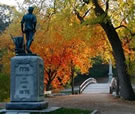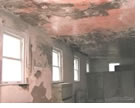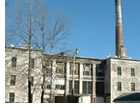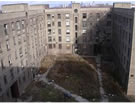

National Trust Lists Most Endangered Places for 2003
Since 1988, America’s 11 Most Endangered Historic Places has identified more than 145 national treasures threatened by neglect, insufficient funds, inappropriate development, or insensitive public policy. “In their amazing diversity, these places tell us who we are as a nation,” says Richard Moe, president of the National Trust. “They constitute an epic cultural narrative whose chapters include not only world-famous icons like MinuteMan National Historical Park but hidden treasures such as the elegant bathhouses of Hot Springs. Unless all of us become aware of the importance of our heritage and take action to preserve it, America’s past won’t have a future. That’s the real message of the 11 Most Endangered list.”
The 11 sites, as listed and presented on the National
Trust Web site, are:
 Urban
Houses of Worship, nationwide. Whether churches, synagogues, meetinghouses,
or mosques, America’s historic urban religious structures are among the
nation’s most significant cultural treasures. In addition to being irreplaceable
architectural landmarks, they are vital community anchors, feeding the
poor, providing meeting space for Girl Scouts and AA groups, and offering
social services ranging from daycare to homeless shelters. Today, they
are falling victim to changing demographics, limited capital budgets,
and soaring real-estate values.
Urban
Houses of Worship, nationwide. Whether churches, synagogues, meetinghouses,
or mosques, America’s historic urban religious structures are among the
nation’s most significant cultural treasures. In addition to being irreplaceable
architectural landmarks, they are vital community anchors, feeding the
poor, providing meeting space for Girl Scouts and AA groups, and offering
social services ranging from daycare to homeless shelters. Today, they
are falling victim to changing demographics, limited capital budgets,
and soaring real-estate values.
 Ocmulgee
Old Fields Traditional Cultural Property, Macon, Ga. Embracing
evidence of 12,000-year-old Ice Age settlements, numerous burial and ceremonial
mounds, and valuable wildlife habitat, this one-time home of the Muscogee
Creek Nation is threatened by a proposed multi-lane highway.
Ocmulgee
Old Fields Traditional Cultural Property, Macon, Ga. Embracing
evidence of 12,000-year-old Ice Age settlements, numerous burial and ceremonial
mounds, and valuable wildlife habitat, this one-time home of the Muscogee
Creek Nation is threatened by a proposed multi-lane highway.
 Amelia
Earhart Memorial Bridge, Atchison, Kans. Opened in 1938 and now
a memorial to a world-famous hometown heroine, this Missouri River span
is slated for demolition and replacement with a new bridge, even though
it is eligible for listing in the National Register of Historic Places.
Amelia
Earhart Memorial Bridge, Atchison, Kans. Opened in 1938 and now
a memorial to a world-famous hometown heroine, this Missouri River span
is slated for demolition and replacement with a new bridge, even though
it is eligible for listing in the National Register of Historic Places.
 East
Side and Middle Schools, Decorah, Iowa. A prominent local landmark
and time-honored symbol of the hopes and dreams of generations of Decorah
residents, the 1896 East Side School is empty, deteriorated, and—along
with the adjoining Middle School built in 1922—facing an uncertain
future.
East
Side and Middle Schools, Decorah, Iowa. A prominent local landmark
and time-honored symbol of the hopes and dreams of generations of Decorah
residents, the 1896 East Side School is empty, deteriorated, and—along
with the adjoining Middle School built in 1922—facing an uncertain
future.
 Zuni
Salt Lake and Sanctuary Zone, Catron and Cibola counties, N. Mex.
Considered sacred by no less than six Native American tribes, this lake
and its surrounding area are threatened by plans to strip-mine coal and
build a 44-mile rail line that will destroy many burial and cultural sites
and possibly drain the lake itself.
Zuni
Salt Lake and Sanctuary Zone, Catron and Cibola counties, N. Mex.
Considered sacred by no less than six Native American tribes, this lake
and its surrounding area are threatened by plans to strip-mine coal and
build a 44-mile rail line that will destroy many burial and cultural sites
and possibly drain the lake itself.
 Little
Manila, Stockton, Calif. Three modest buildings are the last survivors
of the once-bustling neighborhood that housed the largest Filipino community
outside the Philippines. They now could be demolished to make way for
a strip-mall parking lot.
Little
Manila, Stockton, Calif. Three modest buildings are the last survivors
of the once-bustling neighborhood that housed the largest Filipino community
outside the Philippines. They now could be demolished to make way for
a strip-mall parking lot.
 Minute
Man National Historical Park and Environs, Bedford, Concord, Lincoln,
and Lexington, Mass. Heavy air traffic, unchecked noise, and visual intrusions
from a busy regional airport are taking a devastating toll on many important
landmarks, especially this national park on the site where the American
Revolution began.
Minute
Man National Historical Park and Environs, Bedford, Concord, Lincoln,
and Lexington, Mass. Heavy air traffic, unchecked noise, and visual intrusions
from a busy regional airport are taking a devastating toll on many important
landmarks, especially this national park on the site where the American
Revolution began.
 TWA
Terminal at JFK International Airport, New York City. The Port
Authority plans to demolish portions of Eero Saarinen’s 1962 curvilinear
masterpiece and construct a hulking new building behind it, rendering
the Modern icon useless for aviation purposes. (The
Port Authority’s plan)
TWA
Terminal at JFK International Airport, New York City. The Port
Authority plans to demolish portions of Eero Saarinen’s 1962 curvilinear
masterpiece and construct a hulking new building behind it, rendering
the Modern icon useless for aviation purposes. (The
Port Authority’s plan)
 Bathhouse
Row, Hot Springs National Park, Garland County, Ark. Known for
their eclectic architecture and decorative flourishes, six of the eight
surviving buildings along Bathhouse Row are vacant and deteriorated and
in need of viable plans for preservation and reuse.
Bathhouse
Row, Hot Springs National Park, Garland County, Ark. Known for
their eclectic architecture and decorative flourishes, six of the eight
surviving buildings along Bathhouse Row are vacant and deteriorated and
in need of viable plans for preservation and reuse.
 United
States Marine Hospital, Louisville, Ky. Constructed in 1851 through
an act of Congress, this three-story Greek Revival landmark served the
community and the nation faithfully for more than a century but is now
unused and crumbling.
United
States Marine Hospital, Louisville, Ky. Constructed in 1851 through
an act of Congress, this three-story Greek Revival landmark served the
community and the nation faithfully for more than a century but is now
unused and crumbling.
 Michigan
Boulevard Garden Apartments, Chicago. One of the nation’s foremost
examples of visionary workforce housing, this 1929 apartment complex,
constructed by philanthropist Julius Rosenwald, has been vacant for years,
even though it has great reuse potential.
Michigan
Boulevard Garden Apartments, Chicago. One of the nation’s foremost
examples of visionary workforce housing, this 1929 apartment complex,
constructed by philanthropist Julius Rosenwald, has been vacant for years,
even though it has great reuse potential.
Copyright 2003 The American Institute of Architects.
All rights reserved. Home Page ![]()
![]()
 |
||
| For more information on each project, visit the National Trust’s Web site. The History Channel will feature the list at 8:00 p.m. EDT/PDT on July 12 in “America’s Most Endangered,” a one-hour documentary special. Hosted by Roger Mudd, the show is part of the Save Our History campaign, The History Channel’s award-winning national initiative dedicated to historic preservation and history education. A streaming video preview of the program is now available (requires the free Windows Media Player). Watch the May 29 announcement of the 2003 11 Most Endangered Places
at the National Press Club, originally broadcast on C-SPAN.
|
||